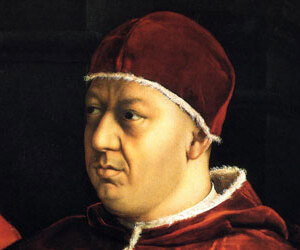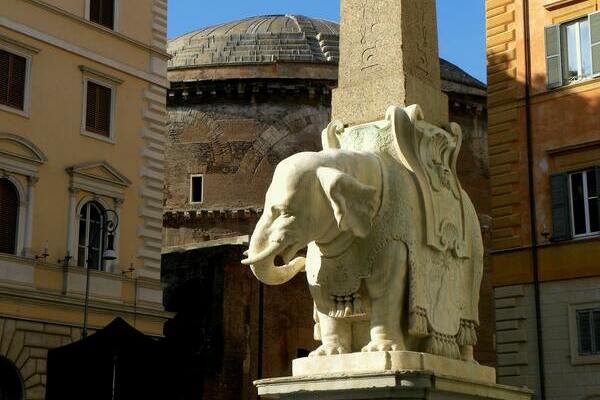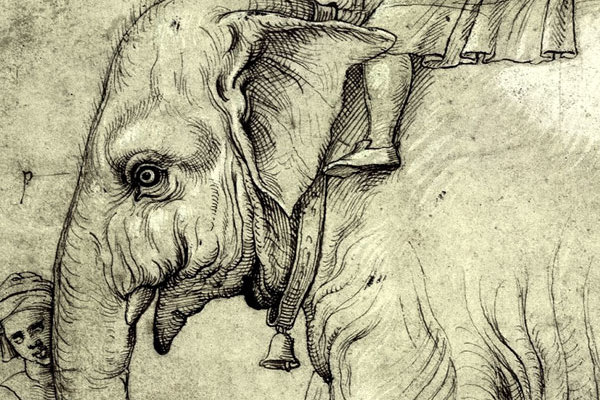The most notable gift from the king of Portugal was an Asian elephant named Hanno, which quickly became the Pope's favorite pet.
On March 9, 1513, muc h to the joy of the Roman people, Giovanni Lorenzo de’ Medici was elected Pope Leo X.
h to the joy of the Roman people, Giovanni Lorenzo de’ Medici was elected Pope Leo X.
Referring to the previous reigns of Alexander VI and Julius II, which were to be eclipsed by the reign of Leo X, the banker Agostino Chigi boldly stated: “The time of Venus has passed; gone also is Mars, and now is the time for Minerva.”
Leo X proved less than successful in politics; rather he is best remembered as a supporter of arts and letters, and of music and learning. He was the most erudite man to have worn the papal tiara up to his time and for long thereafter.
With his pontificate deeply disturbed by shifting political alliances and the Reformation of Martin Luther, Leo sought in vain to establish peace in Christendom and encouraged its expansion with colonization and crusades against the Turks.
The Portuguese empire’s ambitions for colonizing North Africa and the Far East were especially encouraged, as evidenced by the Pope’s exchange of numerous royal gifts with King Manuel I of Portugal.
The most notable gift of all was an Asian elephant named Hanno (Italian: Annone; likely a derivative of aana, which means ‘elephant’ in the Moorish trainer’s native Malayalam language. According to zoologists, elephants do not respond to ‘pet’ names).
In 1514 Hanno’s journey from Lisbon to Rome with the Portuguese ambassador Tristão da Cunha caused quite a sensation.
He was the first elephant to be seen in Rome since the Roman Empire! It is said that when Hanno entered Rome in a grand procession, he stopped in front of Castel St. Angelo (where Pope Leo was watching) and knelt to the ground. After barking 3 times, he plunged his trunk into a nearby trough and filled it with water; he then raised his trunk high in the air and sprayed the pontiff and nearby spectators. Leo was delighted, and Hanno immediately became the pope’s favorite pet.
Hanno entered Rome in a grand procession, stopped in front of Castel St. Angelo (where Pope Leo was watching), and knelt on the ground. After trumpeting 3 times, he plunged his trunk into a nearby trough and filled it with water; he then raised his trunk high in the air and sprayed the pontiff and nearby spectators.
Pope Leo was delighted! For two years Hanno stole the show in numerous Roman festivals, processions, and spectacles; he was so popular, in fact, that Leo commissioned from Raphael a life-sized mural of Hanno at the entrance to the Vatican (this was later destroyed by the construction of Bernini’s colonnades for St Peter’s Square).
Other Hanno art cameos (still visible today) in the Vatican include a wood mosaic on the door between the Stanza della Segnatura and Stanza del Incendio del Borgo, on the Adoration of the Magi tapestry, part of the “New School” series in the Stanza degli Arrazzi, and on 2 frescoes in Raphael’s Loggie in the Apostolic Palace.
You’re probably wondering if Bernini’s elephant in Piazza della Minerva has anything to do with our dear Hanno?
Even though Bernini might have been aware of Hanno’s saga, his inspiration came from elsewhere: from the manuscript Hypnerotomachia Poliphili, published in 1499 by the Dominican Francesco Colonna.
This obscure text contains engravings depicting the protagonist’s dreams, one of which is an elephant carrying an obelisk on its back.
 Find out more about the Bernini's Elephant on our Rome Squares and Fountains Walking Tour!
Find out more about the Bernini's Elephant on our Rome Squares and Fountains Walking Tour!
Hanno’s death in 1516 came as a shock; after days of constipation, he was given a laxative laced with gold, which in effect poisoned him. Leo was so devastated about Hanno’s death that he wanted him buried right where he resided in the Vatican: under the Belvedere courtyard.
Believe it or not, during the 1962 construction of the Vatican Library’s new heating system, several elephant bones were excavated! Portugal later attempted to gift a rhino to the Pope, but sadly the boat that carried the rhino was shipwrecked off the coast of La Spezia.
The rhino washed up on the shores of southern France, was sent back to Portugal and stuffed, and then was later returned to Pope Leo. There is no record, however, of what happened to the poor stuffed rhino after it arrived in Rome.
For further reading, check out The Pope's Elephant, by Silvio A. Bedini.
Discover more on one of our Rome Private Tours!


